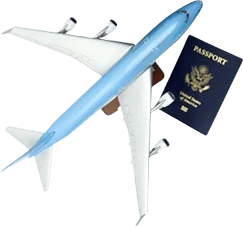
Study in USA

- Study in USA
- Why Study in USA?
- Structure of Education System
- Higher Education in USA
- Intakes
- Tuition Fees and Scholarships
-
Life as an International
Student and Cost of Living -
Work Rights for
International Students in USA - Post-Study Work (PSW)
- Application & Admission Process
-
Requirements for Student Visa
(F-1 or M-1)
Study in USA
Studying in the United States is a dream for many international students, and rightfully so. The USA boasts some of the world's top universities, diverse cultural experiences, and unparalleled opportunities for personal and academic growth. However, navigating the complex process of studying abroad can be daunting. This guide aims to provide a comprehensive overview of everything you need to know about studying in the USA, from choosing the right institution to securing a student visa and adjusting to life in a new country.
Why Study In USA?
Studying in the USA offers numerous advantages and opportunities that attract students from around the world. Here are some compelling reasons why many choose to pursue their education in the United States:
The USA is home to some of the world’s top-ranked universities renowned for their academic excellence, cutting-edge research, and innovative teaching methods. Institutions like Harvard, MIT, Stanford, and Yale consistently rank among the best globally, offering students access to world-class faculty, resources, and facilities.
American universities provide a diverse array of academic programs across various fields of study, including STEM (Science, Technology, Engineering, and Mathematics), humanities, business, social sciences, arts, and more. This breadth allows students to explore their interests, pursue interdisciplinary studies, and tailor their education to their career aspirations.
The USA is a melting pot of cultures, languages, and backgrounds, offering an enriching and multicultural environment for students. Studying in such a diverse community exposes students to different perspectives, fosters cross-cultural understanding, and promotes tolerance and global citizenship.
American universities are at the forefront of research and innovation, providing students with access to cutting-edge research facilities, laboratories, and opportunities to collaborate with leading scholars in their fields. Engaging in research activities enhances students’ academic experience, fosters critical thinking skills, and prepares them for careers in academia, industry, or government.
The USA boasts a dynamic and thriving economy with ample opportunities for internships, co-op programs, and networking connections. Studying in the USA enhances students’ employability and opens doors to a wide range of career opportunities across various industries. Many universities have strong ties to corporations, startups, and research institutions, facilitating job placements and career development initiatives.
The American higher education system offers flexibility and autonomy, allowing students to design their own academic path, select courses of interest, and pursue majors and minors across different disciplines. This interdisciplinary approach encourages creativity, critical thinking, and problem-solving skills, preparing students for success in a rapidly evolving global economy.
Studying in the USA provides students with access to a vast network of alumni, professionals, and experts from around the world. Networking events, career fairs, and alumni associations enable students to establish connections, seek mentorship, and expand their professional networks, which can be invaluable for future career prospects and personal growth.
Structure of Education System in USA
The education system in the United States is diverse and complex, consisting of multiple levels and a variety of institutions. Here’s an overview:
Early Childhood Education
This typically includes preschool programs for children under the age of five, although attendance is not mandatory. Preschools may be public, private, or operated by religious organizations.
Primary Education
Primary education in the United States is usually from kindergarten (around age 5) through to 5th or 6th grade, depending on the state and district. It provides basic education in subjects like math, science, language arts, and social studies.
Secondary Education
Secondary education consists of middle school or junior high (grades 6-8) and high school (grades 9-12). High school education is typically required by law and covers a wider range of subjects, often including elective courses chosen by students based on their interests and career goals.
Higher Education
Higher education in the US includes both undergraduate and graduate programs. Undergraduate education usually leads to a bachelor's degree and can be pursued at universities, colleges, or community colleges. Graduate education includes master's and doctoral programs offered by universities and some colleges.
Higher Education in USA (Undergraduate & Postgraduate Degrees)
Types of Institutions: The U.S. higher education system includes various types of institutions, such as:
Universities: Offering undergraduate, graduate, and professional degrees.
Liberal Arts Colleges: Focused on undergraduate education with a broad curriculum.
Community Colleges: Providing two-year associate degrees and vocational training.
Technical Institutes: Specializing in technical and vocational education.
Research Institutions: Emphasizing research alongside teaching.
Degree Structure: The most common degrees are:
Associate Degree: Two-year degree typically earned at community colleges.
Bachelor's Degree (Undergraduate): Four-year degree conferred by colleges and universities.
Master's Degree: Graduate-level degree requiring 1-2 years of study beyond the bachelor's degree.
Doctoral Degree (Ph.D.): Highest academic degree typically requiring several years of study and original research.
Curriculum: Undergraduate education often includes a mix of general education requirements and courses in a major field of study. Graduate programs are more specialized and focus on research or professional training.
Accreditation: Accreditation ensures that institutions meet certain standards of quality. Regional accreditation is common for universities and colleges, while specialized accreditation may apply to specific programs or fields.
Rankings and Prestige: U.S. institutions are often ranked globally based on factors like academic reputation, faculty quality, research output, and student outcomes. Institutions like Harvard, MIT, Stanford, and others are internationally renowned.
Academic Year Start (Intakes)
In the United States, the academic year typically begins in late August or early September, varying slightly depending on the institution and the type of program. Most universities and colleges follow a semester system, with two main intakes:
Fall Semester
This typically begins in late August or early September and runs through December or early January. Fall intake is the most common intake for undergraduate and graduate programs.
Spring Semester
This usually begins in January and runs through May or early June. Spring intake is less common but still available at many institutions, especially for graduate programs and some undergraduate programs.
Some institutions may also offer additional intakes such as summer sessions, which usually start in May or June and run for a shorter duration, often about 8-12 weeks.
It’s important to note that specific dates may vary between institutions, so it’s advisable for students to check with their chosen universities or colleges for exact start dates and application deadlines.
Tuition Fees and Scholarships
Tuition fees and scholarships in the USA can vary widely depending on the type of institution (public vs. private), location, and specific program of study. Here's a general overview:
Tuition Fees:
Public Universities: In-state tuition fees for public universities are generally lower compared to out-of-state or private universities. However, even in-state tuition can vary significantly from state to state. On average, undergraduate tuition and fees for in-state students at public universities can range from $8,000 to $30,000 per year. Out-of-state tuition can be significantly higher, often ranging from $15,000 to $40,000 per year or more.
Private Universities: Private universities typically have higher tuition fees compared to public universities. Undergraduate and postgraduate degrees tuition fees at private universities can range from $20,000 to $60,000 per year or more.
Scholarships:
Merit-Based Scholarships: These scholarships are awarded based on academic achievement, extracurricular activities, leadership qualities, and other criteria. Merit scholarships can be offered by universities themselves or by external organizations. The amount can vary widely, from a few hundred dollars to full tuition coverage.
Need-Based Scholarships: These scholarships are awarded based on financial need. They can come from the federal government, state governments, universities, or private organizations. The amount awarded depends on the student's financial situation.
Athletic Scholarships: These scholarships are awarded to student-athletes based on their athletic ability. They are offered by universities and can cover tuition, room and board, and other expenses.
Diversity Scholarships: Some scholarships are specifically aimed at promoting diversity and inclusion. These can be based on factors such as ethnicity, gender, or background.
Subject-Specific Scholarships: Scholarships are available for students studying certain fields, such as STEM (Science, Technology, Engineering, and Mathematics), humanities, arts, etc.
Financial Aid: In addition to scholarships, students can also receive financial aid in the form of grants, work-study programs, and loans. The Free Application for Federal Student Aid (FAFSA) is the key application for federal financial aid programs. Many universities also require the CSS Profile for institutional aid consideration.
It's essential for students to research and apply for scholarships and financial aid early in the college application process to maximize their opportunities for funding their education. Additionally, universities often have dedicated offices or websites providing information and assistance regarding scholarships and financial aid opportunities.
Life As An International Student And Cost Of Living
The cost of living for international students in the USA can vary significantly depending on various factors such as the location, lifestyle choices, and individual circumstances. Here’s a rough breakdown of typical expenses that international students might encounter:
Housing costs will depend on whether you choose to live on-campus or off-campus. On-campus housing can range from $8,000 to $15,000 or more per year, while off-campus housing costs can vary greatly depending on the city and the type of accommodation. In major cities, you might expect to pay $800 to $2,000 or more per month for rent, especially if you’re living alone.
The cost of groceries and dining out will depend on your eating habits and dietary preferences. On average, international students might budget anywhere from $200 to $500 per month for food.
Transportation costs will vary depending on whether you use public transportation, own a car, or rely on other means of getting around. Monthly public transportation passes can range from $50 to $200 or more, while owning a car entails additional expenses such as insurance, fuel, and maintenance.
Most universities require international students to have health insurance, which can cost anywhere from $500 to $2,000 or more per year depending on the coverage and the university’s plan
Textbooks and other course materials can add up to several hundred dollars per semester, depending on your course load and field of study.
This includes clothing, entertainment, travel, and other personal items. Personal expenses can vary widely depending on individual preferences and lifestyle choices.
These might include visa application fees, SEVIS (Student and Exchange Visitor Information System) fees, and other administrative expenses associated with studying in the USA.
It’s essential for international students to research the specific costs associated with their chosen university and location, as well as to budget carefully to ensure they can cover all necessary expenses during their time in the USA. Many universities provide resources and cost-of-living estimates to help students plan their budgets effectively.
Work Rights for International Students in USA
International students studying in the USA have certain rights and restrictions when it comes to employment. Here's an overview:
On-Campus Employment: International students on F-1 visas are typically allowed to work on the campus of the institution they are attending without special authorization. However, they are subject to certain restrictions, such as being limited to part-time work during the academic year and full-time work during scheduled breaks.
Off-Campus Employment: Off-campus employment opportunities for international students are more restricted. However, there are two main types of off-campus work authorization available to F-1 students:
Curricular Practical Training (CPT): CPT is work authorization for employment that is an integral part of an established curriculum, such as internships or cooperative education programs. To be eligible for CPT, students must have been enrolled full-time for at least one academic year and must receive authorization from their Designated School Official (DSO).
Optional Practical Training (OPT): OPT allows F-1 students to work off-campus in jobs related to their field of study for up to 12 months (with the possibility of a 24-month extension for STEM fields). OPT requires approval from the U.S. Citizenship and Immigration Services (USCIS).
Other Work Authorization Options: Some international students may be eligible for other types of work authorization, such as:
Severe Economic Hardship: In cases of unforeseen economic hardship, F-1 students may apply for authorization to work off-campus.
Employment with International Organizations: Certain international organizations, such as the United Nations, may offer employment opportunities to international students.
Restrictions and Requirements: It's important for international students to be aware of the restrictions and requirements associated with employment authorization. Working without proper authorization can result in serious consequences, including deportation.
Tax Obligations: International students who work in the USA are generally subject to federal, state, and local taxes. However, there may be tax treaties or exemptions available depending on the student's country of origin.
Work Visas: For international students who wish to work in the USA after completing their studies, obtaining a work visa, such as an H-1B visa, is often necessary. These visas typically require sponsorship from an employer and are subject to annual quotas.
Post-Study Work (PSW)
As of my last update in January 2022, the United States offers various post-study work opportunities for international students through programs like Optional Practical Training (OPT) and the H-1B visa program. Here’s a brief overview of these options:
Optional Practical Training (OPT)
OPT allows international students on F-1 visas to work in the U.S. in their field of study for up to 12 months after completing their academic program. For students in STEM (Science, Technology, Engineering, and Mathematics) fields, there's an extension of 24 additional months, making it a total of 36 months of OPT.
STEM OPT Extension
As mentioned, students in STEM fields can apply for a 24-month extension of their OPT, provided they meet certain requirements. This extension allows them to continue working in the U.S. for a longer period, gaining more experience and potentially increasing their chances of securing employment-based visas like the H-1B.
H-1B Visa
The H-1B visa program allows U.S. employers to temporarily employ foreign workers in specialty occupations. Many international students transition from OPT to H-1B status if they find an employer willing to sponsor them for this visa. The H-1B visa is typically granted for an initial period of three years, with the possibility of extension for up to six years.
Other Employment-Based Visas
Apart from the H-1B visa, there are other employment-based visa categories such as the O visa for individuals with extraordinary abilities, the L visa for intra-company transfers, and the EB-2 and EB-3 green card categories for individuals with advanced degrees or skilled workers, respectively. These options may also be pursued by international students seeking long-term employment in the U.S.
It’s important for international students to stay informed about the latest regulations and policies regarding post-study work opportunities in the U.S., as immigration policies can change over time. Consulting with the international student office at their institution or seeking advice from an immigration attorney can provide up-to-date information and guidance tailored to individual circumstances.
Application & Admission Process
The university admission and application process in the USA for international students can vary slightly from institution to institution, but there are general steps that most students will need to follow. Here's an overview of the typical process:
Research and Shortlist Universities: Begin by researching universities in the USA that offer programs you're interested in. Consider factors such as location, program reputation, tuition costs, and available scholarships.
Check Admission Requirements: Each university will have its own set of admission requirements. Typically, these will include academic transcripts, standardized test scores (such as the SAT or ACT for undergraduate studies, or GRE/GMAT for graduate studies), letters of recommendation, a statement of purpose or personal essay, and proof of English proficiency (usually demonstrated through TOEFL or IELTS scores).
Prepare Application Materials: Once you've identified the universities you want to apply to, start gathering the required documents and information. This may involve obtaining official transcripts, taking standardized tests, drafting your personal statement, and securing letters of recommendation.
Take Standardized Tests: If required, register for and take any necessary standardized tests, such as the SAT, ACT, GRE, or GMAT. Make sure to check the specific requirements of each university you're applying to.
English Proficiency: If English is not your native language, you'll likely need to demonstrate proficiency in English through standardized tests like TOEFL or IELTS. Prepare for and take these tests if required.
Submit Applications: Most universities in the USA use online application systems. Complete and submit your applications through the university's website, ensuring that you provide all required materials and pay any application fees.
Financial Documentation: Many universities will also require proof of financial support to ensure that you can cover the costs of tuition and living expenses while studying in the USA. This may involve submitting bank statements or other financial documents.
Visa Application: Once you receive admission from a university, you'll need to apply for a student visa (typically an F-1 visa for academic study). This process involves completing an application form, paying a fee, scheduling and attending a visa interview at the nearest U.S. embassy or consulate, and providing required documentation such as your passport, Form I-20 (issued by your university), proof of financial support, and evidence of ties to your home country.
Arrival and Orientation: After obtaining your visa, make travel arrangements to the USA. Many universities offer orientation programs for international students to help with the transition to studying abroad.
Maintain Status: Once you arrive in the USA, make sure to maintain your student status by following the rules and regulations set by your university and the U.S. Citizenship and Immigration Services (USCIS). This may include maintaining a full course load, keeping your passport and visa documents up to date, and complying with any employment restrictions for international students.
It's important to note that the application process can be competitive, especially for top universities, so be sure to start early, carefully review each university's requirements, and submit all materials by the specified deadlines. Additionally, consider reaching out to the admissions offices of the universities you're interested in for personalized guidance and assistance throughout the application process.
Requirement For Student Visa (F-1 Or M-1)
Obtaining a student visa to study in the United States typically involves several steps and requirements. Here’s an overview of the process and key requirements for a student visa (F-1 or M-1) in the USA:
The first step is to apply and be accepted into a U.S. institution certified by the Student and Exchange Visitor Program (SEVP). This can be a university, college, language school, or other academic institution.
Once accepted, the institution will issue a Form I-20 (for F-1 visas) or DS-2019 (for M-1 visas), which is a Certificate of Eligibility for Nonimmigrant Student Status. This form is needed to apply for a student visa.
Before applying for a visa, students must pay the SEVIS (Student and Exchange Visitor Information System) fee. This fee supports the maintenance of the SEVIS database.
Students must complete the DS-160 form online. This form collects basic biographical information and details about the purpose of the trip.
After completing the DS-160, applicants need to schedule a visa interview at the nearest U.S. embassy or consulate. Wait times for interview appointments can vary by location and time of year, so it’s advisable to schedule the interview well in advance.
During the visa interview, applicants will be required to provide documentation to support their application. This may include the Form I-20 or DS-2019, proof of SEVIS fee payment, proof of funds to cover tuition and living expenses, academic transcripts, standardized test scores (such as TOEFL or SAT), and any other relevant documents.
Depending on the program of study, applicants may need to demonstrate proficiency in English by taking a standardized test such as the TOEFL or IELTS.
Applicants must demonstrate that they have sufficient funds to cover tuition, living expenses, and other costs associated with studying in the United States. This can be done through bank statements, scholarship letters, or other financial documents.
Applicants must demonstrate that they have strong ties to their home country and intend to return upon completion of their studies. This can be shown through documentation of family ties, property ownership, employment prospects, etc.
Some schools may require proof of health insurance coverage, so applicants should check with their institution for any specific requirements.
There is a non-refundable visa application fee that must be paid before the interview.
It’s important for applicants to check the specific requirements and procedures for their country of residence, as processes may vary slightly depending on the location of the U.S. embassy or consulate. Additionally, visa regulations and requirements are subject to change, so it’s advisable to consult the official website of the U.S. Department of State for the most up-to-date information.
Start Your Journey Today!


Embark on your educational adventure in the USA, a beacon of academic excellence and cultural diversity! Experience top-tier universities, cutting-edge research facilities, and a thriving academic community. From iconic cities to picturesque campuses, the USA offers a dynamic learning environment tailored to your ambitions. Explore a wide range of disciplines, engage with renowned scholars, and immerse yourself in the vibrant tapestry of American culture. Build a global network of peers and mentors while pursuing your dreams in the land of opportunity. Start your journey today and pave the way for a bright future. Study in the USA – where every dream has a chance to flourish!




